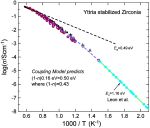EPJ B Highlight - Unlocking fuel cell conductivity
- Details
- Published on 17 March 2013

Work on a high-conductivity material demonstrates the role of oxygen ions in enhancing their capabilities
Yttria stabilized zirconia, also known as YSZ, is a material of great interest because of its relatively high oxygen-ion based conductivity. In particular, it finds applications in electrochemical devices, such as solid oxide fuel cells and oxygen sensors. In a study published in EPJ B, Kia Ngai, from the University of Pisa in Italy, and colleagues from the Complutense University in Madrid, Spain, devised a model of the oxygen-ion dynamics that contribute to the conductivity of YSZ.
The problem is that fuel cells currently operate above 700 ºC, which strongly limits their use. Understanding oxygen-ion diffusion is key to helping lower operating temperature down to room temperature. Previous attempts to do so were done with the so-called coupling model (CM), describing simple physical concepts related to ion-ion interaction. This helped uncover the importance of ion-ion correlation in limiting long-range ion mobility, and thus conductivity.
The trouble is that experiments show that ionic conductivity in YSZ requires an activation energy that is much higher than that supplied by computer simulations describing independent ion hopping. Relying on the CM model, the authors first established a quantitative description of the ion dynamics in YSZ. Then they compared the predictions of the CM with experimental results and with simulations, particularly those of nanometric-scale thin films, published in the last ten years.
Thus, in their model, they established the connection between the level of the energy barrier for independent ion-hopping simulations and the level of activation energy measured experimentally for long-range movement of oxygen ions. In addition, they attributed an increase of the conductivity in nanometers-thick YSZ films to a decrease in the ion-ion correlations. This model could also be used to study the conductivity relaxation of so-called molten, glassy and crystalline ionic conductors and ambient temperature ionic liquids.




